
La Plata is the capital city of Buenos Aires Province, Argentina. According to the 2022 census, the Partido has a population of 772,618 and its metropolitan area, the Greater La Plata, has 938,287 inhabitants. It is located 9 kilometers inland from the southern shore of the Río de la Plata estuary.

Club Estudiantes de La Plata, simply referred to as Estudiantes de La Plata, is an Argentine professional sports club based in La Plata. The club's football team currently competes in the Primera División, where it has spent most of its history.
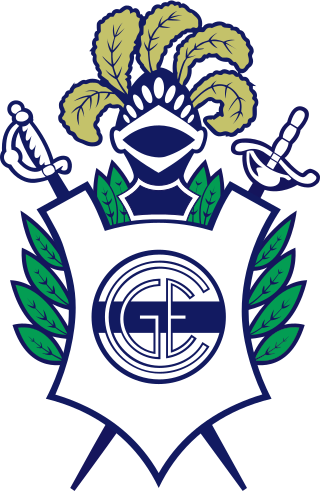
Club de Gimnasia y Esgrima La Plata, also known simply as Gimnasia, is an Argentine professional sports club based in the city of La Plata, Buenos Aires Province. Founded in 1887 as "Club de Gimnasia y Esgrima", the club is mostly known for its football team, which currently plays in Primera División, the first division of the Argentine football league system. The club was most famously managed by footballing legend Diego Maradona, from September 2019 until his death in November 2020.
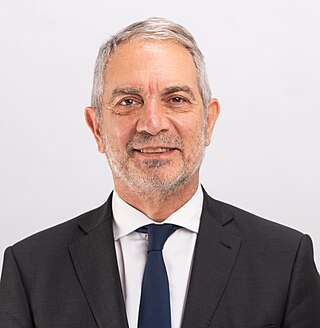
Julio César Alak is an Argentine politician. Since 10 December 2023, intendente (mayor) of La Plata, the capital city of Buenos Aires Province. He previously held the post from 1997 to 2007.

Malvinas Argentinas Stadium is a stadium in the city of Mendoza in the homonymous province of Argentina. With a seating capacity of 42,000 spectators, the stadium is the largest in Mendoza. Built for the 1978 FIFA World Cup, It is owned and administered by the Provincial Government.

The Estadio Único Diego Armando Maradona is a multi-purpose stadium located in Tolosa, La Plata Partido, next to the city of La Plata, Argentina. It is also known popularly as the Estadio Único and is owned by Buenos Aires Province, administered jointly by the provincial government, the Municipality of La Plata, and the football clubs Estudiantes de La Plata and Gimnasia y Esgrima de la Plata.

The Juan Carmelo Zerillo Stadium, popularly known as El Bosque, is a football stadium located in the city of La Plata, Argentina. It is located on 60th Avenue and its intersection with 118th Street. It is the stadium of the Club de Gimnasia y Esgrima La Plata, and nowadays has the capacity to accommodate approximately 30,973 spectators.
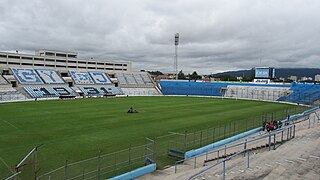
23 de Agosto Stadium, nicknamed La Tacita de Plata, is a football stadium in San Salvador de Jujuy, Argentina. The stadium is owned and operated by local club Gimnasia y Esgrima.

Estadio El Gigante del Norte is a football stadium located in the city of Salta in the homonymous province of Argentina. It is owned and operated by local club Gimnasia y Tiro and was opened in the 1920s. The stadium has a capacity of 24,300 spectators.
Torneos de Verano are a series of short friendly football pre-season tournaments held during the southern summer in Argentina every year, usually in January and February. They serve as preparation for the teams for the season coming; however, as the years have gone by, the competitiveness in the tournaments has increased, and they are now considered as important competitions. This is clearly reflected in the high crowd attendance for the games.
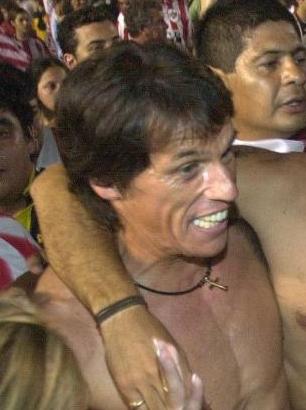
José Luis Calderón is an Argentine former professional footballer who played as a striker. He played for 17 years between 1989 and 2006 without winning a trophy, but between the ages of 36 and 39 he won four major championships with three teams.

Mariano Andújar is an Argentine former professional footballer who played as a goalkeeper.
Juan José Muñoz was an Argentine businessman. He was an advisor to the current Minister of Interior, Mr. Aníbal Fernández, during the period when the latter was a federal senator. Afterwards, he worked for the trade union that represents State Workers.

Club de Gimnasia y Esgrima is an Argentine multi-sports club placed in the city of Buenos Aires. The institution is one of the oldest in the country, having been established in 1880. Gimnasia y Esgrima is also one of the largest clubs of Argentina, with around 30 different disciplines hosted in the three buildings that the institution owns in Buenos Aires.
Club de Gimnasia y Esgrima La Plata was founded on June 3, 1887, as "Club de Gimnasia y Esgrima", initially with fencing as its main activity, as its name in Spanish indicated. Association football was added at the beginning of the 20th century.
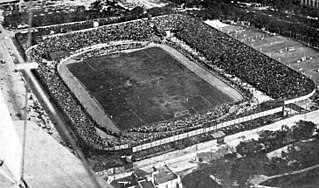
The Estadio Alvear y Tagle was a stadium in Buenos Aires, Argentina. The venue had a capacity for 40,000 spectators and was located on Alvear, in the Recoleta district. Opened in 1923, it was rented and operated by Club Atlético River Plate, being used as its home venue until the club inaugurated the Estadio Monumental in 1938.
The 2010–11 Primera División season was the 120th season of top-flight professional football in Argentina. A total of 20 teams competed in two championships —the Apertura and Clausura— over the course of the season, which started on August 6, 2010 and ended on June 30, 2011, one day prior to the start of the 2011 Copa América, held in Argentina.
Lucas Calderón is an Argentine former professional footballer who played as a forward and his last team was C.A. Bella Vista.

The 1918 Copa de Honor Municipalidad de Buenos Aires Final was a football match that decided the champion of the 13th. edition of this National cup of Argentina. In the match, held in Estadio GEBA in Buenos Aires, Independiente defeated Platense 1–0. winning its first Copa de Honor trophy.
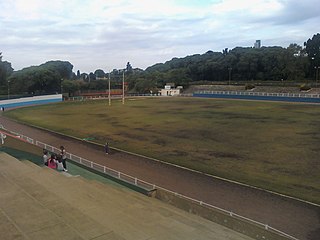
The Estadio GEBA is a stadium located in the Palermo neighbourhood of Buenos Aires, Argentina. Owned by Club Gimnasia y Esgrima, the stadium is located on the "Sede Jorge Newbery", one of the three facilities of the club. Its current capacity is 12,133 spectators.






















